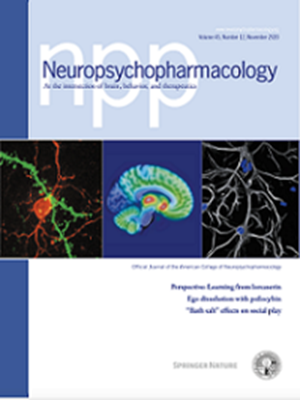Mitogen-activated protein kinase dependent presynaptic potentiation in the lateral habenula mediates depressive-like behaviors in rats
IF 6.6
1区 医学
Q1 NEUROSCIENCES
引用次数: 0
Abstract
Emerging evidence suggests that the enhanced activity of lateral habenula (LHb) is involved in depressive disorders. This abnormal potentiation of LHb neurons was shown to originate from presynaptic alterations; however, the mechanisms underlying this presynaptic enhancement and physiological consequences are yet to be elucidated. Previously, we reported that presynaptic transmission in the LHb is temporally rhythmic, showing greater activity in the afternoon than in the morning. Here, we used a learned helpless rodent model of depression to show that exposure to a stressor or incubation with the stress hormone, corticosterone, abolished the presynaptic temporal variation in the LHb. In addition, selective inhibition of mitogen-activated protein kinase (MAPK) kinase (MAPKK, MEK) activity in the LHb restored the presynaptic alteration even after stress exposure. Moreover, we observed a slight increase in phosphorylated synapsin I after stress exposure. Finally, we found that a blockade of MAPK signaling before stress exposure successfully prevented the depression-like behaviors, including behavioral despair and helplessness, in an acute learned helpless animal model of depression. Our study delineates the cellular and molecular mechanisms responsible for the abnormal presynaptic enhancement of the LHb in depression, which may mediate depressive behaviors.

依赖于突触前电位的外侧哈文神经元介导大鼠的抑郁样行为
新的证据表明,外侧哈氏神经元(LHb)活动的增强与抑郁症有关。LHb 神经元的这种异常电位增强被证明源于突触前的改变;然而,这种突触前增强的机制及其生理后果仍有待阐明。此前,我们曾报道 LHb 的突触前传递具有时间节律性,下午比上午更活跃。在这里,我们利用学习性无助抑郁啮齿动物模型证明,暴露于应激源或应激激素皮质酮的孵育会取消 LHb 的突触前时间变化。此外,选择性抑制 LHb 中的丝裂原活化蛋白激酶(MAPKK,MEK)活性可恢复突触前的变化,即使在暴露于应激后也是如此。此外,我们还观察到应激暴露后磷酸化突触素 I 略有增加。最后,我们发现,在急性习得性无助抑郁动物模型中,在暴露于应激前阻断 MAPK 信号转导成功地防止了类似抑郁的行为,包括行为绝望和无助。我们的研究阐明了导致抑郁症患者突触前 LHb 异常增强的细胞和分子机制,这种机制可能是抑郁行为的介导因素。
本文章由计算机程序翻译,如有差异,请以英文原文为准。
求助全文
约1分钟内获得全文
求助全文
来源期刊

Neuropsychopharmacology
医学-精神病学
CiteScore
15.00
自引率
2.60%
发文量
240
审稿时长
2 months
期刊介绍:
Neuropsychopharmacology is a reputable international scientific journal that serves as the official publication of the American College of Neuropsychopharmacology (ACNP). The journal's primary focus is on research that enhances our knowledge of the brain and behavior, with a particular emphasis on the molecular, cellular, physiological, and psychological aspects of substances that affect the central nervous system (CNS). It also aims to identify new molecular targets for the development of future drugs.
The journal prioritizes original research reports, but it also welcomes mini-reviews and perspectives, which are often solicited by the editorial office. These types of articles provide valuable insights and syntheses of current research trends and future directions in the field of neuroscience and pharmacology.
 求助内容:
求助内容: 应助结果提醒方式:
应助结果提醒方式:


